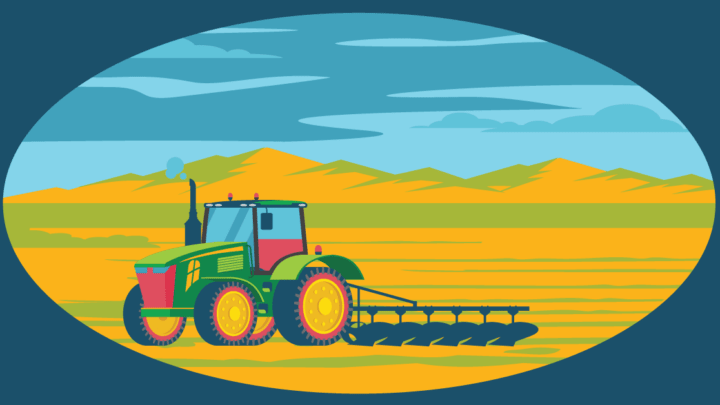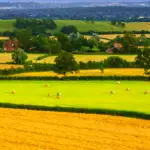We all know how important farmland is: it’s where our food comes from, the origin of many commodities that might be in our portfolios, and is a crucial component of the American (and global) economy. What you may not realize is that it’s also a thriving investment sector.
You’d be forgiven if farmland investing isn’t on your financial radar, as it’s essentially been out of reach for Main Street investors for decades. Now, however, individual investors can incorporate farmland into their portfolio through crowdfunding platforms like FarmTogether.
These are many reasons an investor might consider including farmland in their portfolio. Farmland is historically inflation-resistant, has enjoyed consistent performance even when markets are shaky, offers welcome diversification, and can provide investors with a passive income stream.
Here’s what you need to know about farmland investing.
Table of Contents
Why You Might Not Be Familiar With Farmland Investing
For years, the farmland investing space was dominated by institutional investors and high net worth individuals. The biggest holders of farmland were the families who owned the farms, followed by pension funds and insurance companies alongside large-scale investment funds. By the early 2000s the scarcity of farmland, coupled with rising food prices, made farmland a hot commodity.
Here’s how farmland has compared to the Dow Jones Industrial Index and the S&P 500 from 2000 to present. Note that it outperformed markets even during the depths of the 2008 financial crisis and, more recently, COVID-19 volatility.
Source: USDA ERS, Yahoo! Finance
Although farmland was in the midst of a golden age, there were few, if any, ways into the market for your average investor. You had to have big bucks to invest via a hedge fund or private equity firm, or buy a farm outright on your own. There was no viable way to directly incorporate farmland assets into your portfolio; the closest you could get was often through index funds or real estate investment trusts (REITs). REITs are common methods for investors to own fractions of an overall property, providing you with the option to obtain passive income by way of your investment. There are drawbacks to REITs, however: namely their correlation to the stock market. REITs demonstrate high correlation to markets, which means they’re more likely to swoon during a sell-off.
Farmland Investing, Democratized
This has changed with the advent of tech-driven fractional ownership, which enables investors to allocate smaller amounts of money behind assets that once required major amounts of capital. Platforms such as FarmTogether do all the heavy-lifting, from researching investment opportunities to partnering with best-in-class operators, in order to remove the barriers that once stood in the way. Now investors can right-size farmland’s role in their portfolio, all while owning shares of a farm outright.
The Investment Benefits of Farmland Investing
There’s never been a better, easier time to invest in farmland. This asset class has long served as a hedge against inflation, which is now sitting at a 39-year high. There’s also little value opportunity in the stock market, which has fluctuated significantly in the wake of COVID-19. Interest rates continue to scrape bottom, leaving investors without an appetite for bonds. And, at the same time, ESG investing continues to match—or even beat—conventional investment holdings.
For Enhanced Diversification
Portfolio diversification is a must, but doing it the right way is trickier than most investors realize. Building a portfolio with heaps of different (often overlapping) stocks and funds doesn’t actually provide you with the degree of diversification you might think. Worse, it could even increase your exposure and cause you unnecessary management fees for overlapping holdings in different funds.
Many alternative investments, despite being separate from the stock market, share some level of proximity to conventional investments and the economy in general. They may rise or fall in tandem with markets depending on their market correlation—the extent to which their underlying value is driven by conventional assets. In other words, some alternatives are impacted by market moves more than others.
Farmland investing is one alternative asset that has historically enjoyed low correlation with the stock market, bonds, gold, and even real estate, which means it’s less susceptible to losses in value when the markets dip (or even dive). This lack of correlation is due to the fact that farms are essential to the food supply chain, meaning they’re less likely to lose or gain value based on what happens on Wall Street.
These are just some of the reasons why farmland has one of the lowest correlation factors in the world of alternatives, making it a solid option for a well-balanced portfolio. Even if markets take a tumble, your farmland investment is less likely to take a hit. Farmland investments also have different target hold periods, which give you even more diversification opportunities. That’s something other investments can’t necessarily match.
As an Inflation Hedge
Inflation is on the rise—and it looks like it won’t be going away anytime soon. The Consumer Price Index (CPI), the most common metric economists use to track inflation, shot up by 6.8% in November 2021 compared to a year ago. Supply chain problems linger as well, which will likely continue to drag the economy and the stock market as a result.
Inflation typically causes stock prices to fall for businesses with broad exposure to consumer spending, oftentimes leaving your stock and fund positions vulnerable to disruption. Add supply chain disruptions to the fold and we can also expect other, non consumer-facing sectors to feel the pain as well.
Many alternative investments—farmland in particular—can be resistant to inflation pressures because they tend to retain value over time. Farmland’s scarcity value, coupled with its role in the commodities market, can make farmland an excellent hedge against inflation.
Passive Income Opportunities With Strong Returns
Farmland investing is designed to generate passive income over the long term for investors, through rental payments, crop sales, and appreciation. This means that it may provide you with an opportunity to generate income without having to actively manage your investment.
The products and goods generated by farmland creates passive income for land investors based on your stake in the farm. You earn a portion of the profits when goods go to market, making your money work harder for you. Plus, when inflation is on the rise, the cost of goods at market increases as well, meaning stronger returns for investors.
Investing in farmland has a steady track record of strong returns. The increasing scarcity of farmland has made existing farms scarcer and more valuable, all while the global demand for food has increased sizably every decade. FarmTogether’s investment returns range from 7 to 15% on average and 3 to 9% cash yields.
These returns typically keep up with or exceed your typical market return, meaning you’re getting more out of the money you put into farmland holdings.
The Sustainability Benefits of Farmland Investing
ESG investing has come of age. Now, environmental, sustainability, and governance-driven investments can create the same (or better) returns than portfolios and holdings not designed with these factors in mind.
Farmland investing can do more than diversify your portfolio and hedge your assets against inflation. The money you put behind farmland opportunities can help foster the future of sustainable agriculture. By directly investing in farmland, investors can help farmers implement the environmentally sustainable tools needed to meet the global demand for food that’s expected to double by 2050.
There are many ways to incorporate ESG into your portfolio, but few opportunities give you direct exposure to sustainability the way that farmland investing does. As the partial owner of one or several farms, you can have a seat at the table to help direct environmentally friendly practices and to be part of the long-term climate solution.
Adding Farmland to Your Portfolio
FarmTogether makes it easy to incorporate farmland into your portfolio. They offer a range of investment types – from pistachio and avocado orchards to corn and soy farms – making it easy to invest based on length, crop type, anticipated rate of return, and more. Their farmland investing experts size up the right opportunities and FarmTogether conducts rigorous due diligence on the opportunities they provide. This means you can enter the farmland investing space without needing to become a subject matter expert.
If you’re interested in learning more about farmland investing, the role it can play in your portfolio, or the variety of investment solutions FarmTogether offers, you can always check out their FAQ. Or, open a FarmTogether account in a matter of minutes, after which you can explore their range of open investment options.
Hi, I’m John Hawrylack! I’m a husband, dog dad and FIRE enthusiast. My love and passion for personal finance started when I was a teenager and grew as I worked in the finance industry. My goal is to help others discover their version of FIRE. I have a BS in Computer Science and MS in Software Engineering. Our blog has been mentioned in Forbes, MSN, Yahoo, Fox Business, U.S. News & World Report, Ladders, GOBankingRates, Debt.com, VOYA, ChooseFI and many more!


